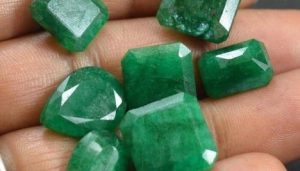Emerald is not only beautiful, but also quite valuable. Accordingly, the question of its authenticity is extremely relevant. In this article, we will look at effective methods by which you can determine the authenticity of an emerald without leaving your home.

Appearance of the stone: first signs
The appearance of an emerald is one of the most accessible criteria for assessing its authenticity. What does a natural emerald look like and what are the first signs you should pay attention to?
Natural emerald usually has a rich green color with deep hues. Unlike artificial stones, the color will not be uniform and may include different shades of green. The purity of the stone is also an indicator: natural emeralds often have internal inclusions that are absent or minimal in their artificial counterparts.
Cultured emeralds are often perfectly cut and symmetrical in shape.This is suspicious, since natural stones are rarely perfect. The cut of a natural emerald is often chosen to maximize the stone's natural color and brilliance and may not always be symmetrical.
Natural emeralds may have minor surface imperfections, such as scratches or dents, that are not typically found on man-made stones. These defects should not be considered a flaw; on the contrary, they can serve as proof of the authenticity of the stone.
Before making final conclusions about the authenticity of an emerald, it is recommended to conduct a comprehensive study, including other methods of analysis. However, the appearance of the stone can give an initial indication of its authenticity and quality.
Transparency and color
What does a natural emerald look like? It has a deep green color and high transparency. If the stone looks too perfect or its color seems artificial, you should think about its authenticity.
It should also be noted that the color of emerald can vary from light green to dark green. This depends on the concentration of chromium and vanadium in the crystal lattice of the mineral.
Verification tests: density and thermal conductivity
After the introductory examination, you should proceed to more advanced analysis techniques. One such method is to determine the density of an emerald. This process requires the use of a scale and water. How to determine the density of an emerald? Calculate density by immersing a stone in liquid and measuring the volume of water displaced.
If you do not have the appropriate tools to measure density, you can use a thermal conductivity test.You will need an ordinary metal object and the emerald itself. Authentic emerald is characterized by high thermal conductivity and heats up quickly.

How to check an emerald using available tools?
One of the most accessible methods is to use a magnifying glass. Under a magnifying glass, a real emerald will have a complex structure of inclusions, which is a characteristic feature of natural stones.
This test is especially useful if you have the opportunity to compare the stone you are studying with already known genuine samples. Such a comparison will allow you to quickly draw a conclusion about authenticity.
How to distinguish emerald from glass or artificial analogues?
One of the effective methods for determining the authenticity of an emerald is to compare its characteristics with known materials, such as glass and artificial analogues. How to distinguish emerald from glass or synthetic substitutes? To do this, you need to take several key parameters into account.
Real emerald usually feels cooler to the touch compared to glass or plastic substitutes. This is due to the different thermophysical characteristics of these materials.
Glass and synthetic materials usually have a different index of refraction of light, which can be noticeable when looking closely at the stone. If the emerald is placed next to known examples of glass or artificial analogues, the difference in the refraction of light becomes obvious.
Real emerald often has natural inclusions and imperfections that are absent or minimal in glass and synthetic counterparts. These inclusions can be examined under a magnifying glass or microscope.
Chemical reagents can be used as an additional test, but this method requires specialized knowledge and experience and is best performed in a laboratory setting.
By comparing an emerald with known materials using these parameters, you can establish its authenticity with a high degree of confidence or identify a fake.


 0
0





